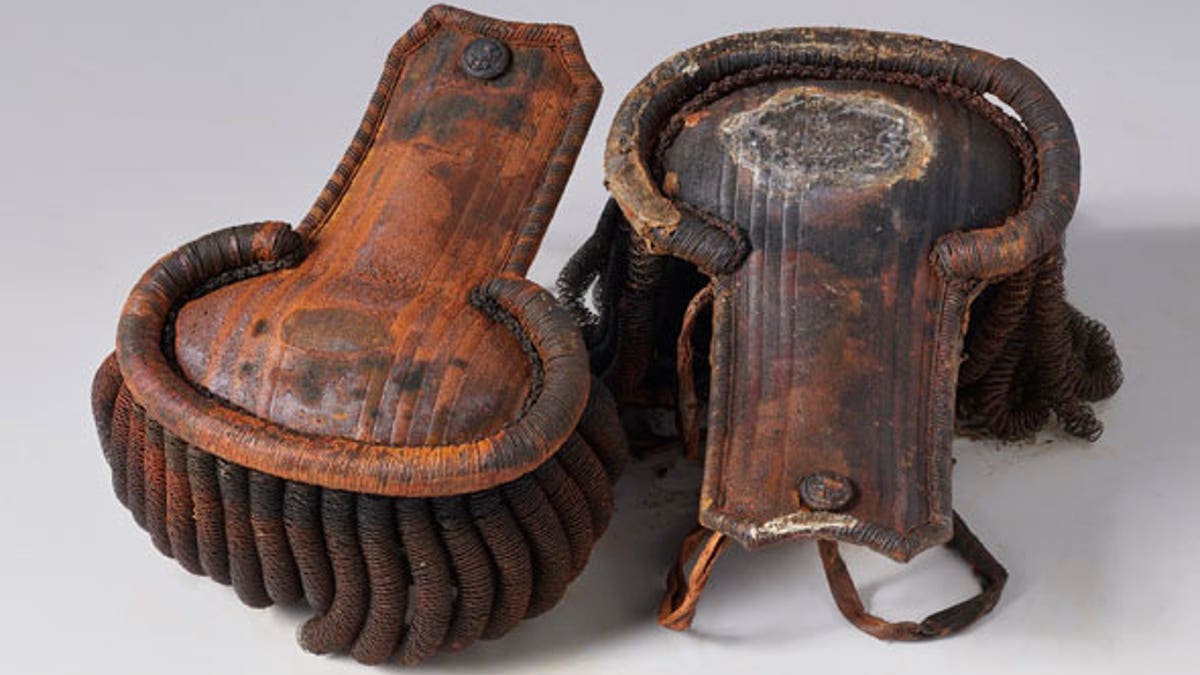Long-lost HMS Terror finally discovered
Researchers discover long-lost HMS Terror 168-years after Sir John Franklin's doomed ship wreck
Stunning artifacts have been recovered from the wreck of HMS Erebus, one of two 19th-century Royal Navy ships involved in a doomed expedition to locate the Northwest Passage.
Officials in Canada unveiled the items, which include epaulets from a lieutenant’s uniform, ceramic dishes, a hairbrush, and a pencil case, this week. Sealing wax, bearing a fingerprint, that is believed to belong to Edmund Hoar, the captain’s steward, was also found.
HMS Erebus and her sister ship HMS Terror took part in an expedition led by Sir John Franklin to find the long-sought sea route. Both ships’ crews perished in the mission and the ships' final resting places remained a mystery for over 160 years.
INCREDIBLE IMAGES REVEAL 'FROZEN-IN-TIME' SHIPWRECK HMS TERROR
Parks Canada and the Inuit Heritage Trust unveiled the new artifacts on Thursday.
“The findings from HMS Erebus during the 2019 Franklin research mission will contribute to a better understanding of historical and Inuit accounts of the Franklin Expedition and help establish a clearer picture of the living quarters of the crew on the lower deck of the ship,” said Parks Canada in a statement.

The pair of epaulets recovered from the wreck of the HMS Erebus. Experts think that the epaulets belong to James Walter Fairholme, a 3rd lieutenant on HMS Erebus. (Parks Canada)
The items were recovered from HMS Erebus during 93 dives that took place over a three-week period in fall 2019, according to Parks Canada. Divers spent approximately 110 hours underwater.
“The recovered artifacts are currently undergoing preliminary analysis – a process that includes identifying the physical characteristics of each object as well as scaled illustrations, x-rays and studio photography – at Parks Canada’s Conservation Laboratories,” explained Parks Canada in a statement.
The wreck of the Erebus was finally located in 2014, amid much fanfare, and the Terror was found two years later. The ships, which were among the most sought-after prizes in marine archaeology, are the subject of multiple songs, poems and novels. The wrecks have even sparked talk of a modern "curse."
DOOMED 1840S ARCTIC EXPEDITION SPARKED TALK OF A MODERN 'CURSE'
Last year Canadian officials released remarkable, never-before-seen images and video footage of the HMS Terror wreck. The images were captured during what is described as the largest and most complex underwater archaeology project in the country’s history. Using an undersea drone, researchers explored the remarkably well-preserved interior of the HMS Terror.

A hairbrush was discovered in one of the officer's cabins on the HMS Erebus. Some human hairs were recovered from the bristles. DNA analysis may identify the brush's owner. (Parks Canada)
What happened to most of the ships' crew members, however, is still unknown. Franklin and 128 handpicked officers and men had set out in 1845 to find the Northwest Passage, the shortcut to Asia that supposedly ran from the Atlantic to the Pacific by way of the harsh, ice-choked Arctic.
Experts believe that the ships were lost in 1848 after they became locked in the ice near King William Island and that the crews abandoned them in a hopeless bid to reach safety. Inuit lore tells of "white men who were starving" as late as the winter of 1850 on Royal Geographical Society Island in the north Canadian territory of Nunavut.
ENTIRE ARCTIC EXPEDITION PERISHED, BUT NOT BECAUSE OF LEAD
The fate of the sailors and Royal Marines on the Franklin expedition continues to captivate historians.

Sealing wax recovered from the pantry (storage room) of the captain's steward on HMS Erebus. The wax, which was used to seal letters and envelopes, is marked "Extra Fine London." (Parks Canada)
The ships’ crews all perished in the icy wastes of the Canadian Arctic and the bodies of most of the expedition members have never been recovered. However, a handful of graves have been found and the remains examined.
One theory suggests that lead poisoning from shoddily canned food and the ships’ water filtration system helped doom the expedition. However, research published last year in the journal Plos One challenges this notion. After analyzing bone and dental remains of crew members and comparing them to samples from a Royal Navy cemetery in the Caribbean, the researchers concluded that many of the crew were likely victims of starvation.
SEARCHERS FIND 2ND SHIP FROM DOOMED BRITISH EXPEDITION

The pencil case was discovered in a drawer in what is believed to be the Captain's Steward's pantry. (Parks Canada)
The local community treats the wreck sites with great reverence.
“An Inuit Guardians program, involving Inuit from Gjoa Haven, has been in place since 2017 and leads the protection and monitoring of the Franklin wrecks during the open-water season, in addition to helping integrate Inuit knowledge into Parks Canada’s operations,” said Parks Canada in its statement released this week.

A decanter, thought to have been used for brandy or port, was found in the officers' mess on HMS Erebus. (Parks Canada)
CLICK HERE TO GET THE FOX NEWS APP

1845: The ships HMS Erebus and HMS Terror used in Sir John Franklin's ill-fated attempt to discover the Northwest Passage. Original Publication: Illustrated London News pub 24th May 1845. (Photo by Illustrated London News/Getty Images)
Both wrecks have been designated as historic sites by the Canadian government and a Parks Canada permit is required to access them.
The Associated Press contributed to this article.
Follow James Rogers on Twitter @jamesjrogers

